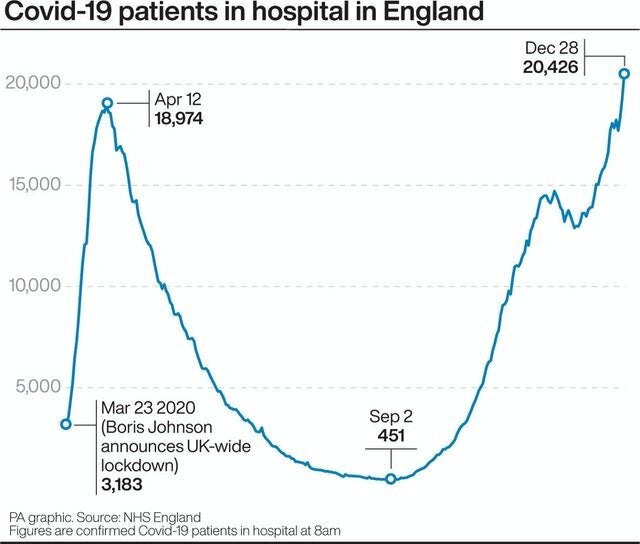The number of Covid cases and hospitalisations have surged to record highs in England over Christmas.
NHS chiefs in the south of the country have now warned services are being stretched to levels not seen since the first wave in April, and they are expected to get worse due to the increased socialising during the festive period.
For anyone who has understandably stepped back from the news over the last few days, here’s where things stand...
Cases
The number of further lab-confirmed cases of coronavirus recorded in a single day in the UK hit a new high of 41,385 as of 9am Monday, rising above 40,000 for the first time.
Cases figures do not include information from Scotland and Northern Ireland, which did not report data between December 24 and 28, meaning the true number is even higher.
Modelling estimates of the number of daily infections during the peak of the first wave in March and April vary but range from 144,000 to 285,00.
The latest data from two of these models suggests the true number of daily infections on December 20 in the UK was around 100,00.
Hospitalisations
As reported on Monday, England’s hospitals now have more Covid-19 patients than during April’s first-wave peak and a health boss warned doctors and nurses are “back in the eye of the storm”.
NHS England figures show there were 20,426 patients in NHS hospitals in England as of 8am on Monday, compared to the 18,974 patients recorded on April 12.
Of these, 1,641 have required mechanical ventilation. This is 57% of the highest daily total during the peak of the first wave, 2,881 on 12 April.
What’s concerning is the lag between cases being detected and symptoms becoming severe enough to require hospital treatment – typically there is a lag of a few weeks between people testing positive for the virus, then a rise in hospitalisations, and then a rise in deaths.
Therefore the inevitable rise in cases and hospitalisations that will occur due to an increase in socialising over the Christmas period will not happen until early January.

Dr Nick Scriven of the Society for Acute Medicine, called the trend “extremely worrying” and said “systems will again be stretched to the limit”.
“It is not ‘just the case’ of using the Nightingale hospital as there are simply no staff for them to run as they were originally intended (mini intensive care units),” he said.
“They could play a role perhaps if used as rehabilitation units for those recovering but, again, where do we find the specialist staff – the NHS simply does not have the capacity to spare anyone.”
Rise in cases
Just last week, all but one of the areas with the highest increase in cases – York – over a seven-day period were in the south of England.
But on Monday, York was joined by Gateshead, Wirral, Rutland and Stockport.
Sefton, Cumbria and North Yorkshire now also feature in the top 20.
The figures below show the increase in cases, with cases per 100,000 people in brackets. For context, the government’s own threshold for quarantining overseas travellers is 20 cases per 100,000 people over a seven-day average.
Brits visiting countries with higher case rates are required to quarantine for 10 days upon their return.
Currently in England the region with the highest case rate is Thurrock with a staggering 1,115.1 cases per 100,000 people.
Where cases are rising the fastest
- York 109% (264.9 cases per 100,000 people)
- Isle of Wight 101% (210.2)
- Gateshead 82% (260.3)
- Plymouth
- Cornwall and Isles of Scilly 72% (124.2)
- Rutland 68% (172.8)
- Wirral 64% (225.6)
- Windsor and Maidenhead 57% (491.3)
- Stockport 53% (208.9)
- Southampton 53% (329.5)
- Sefton 47% (182.3)
- Cumbria 46% (232.0
- Bournemouth 45% (225.9)
- West Sussex 44% (306.0)
- Dorset 42% (123.1)
- Hampshire 42% (292.1)
- Wiltshire 41% (156.4)
- Swindon 40% (269.6)
- Bath and north-east Somerset 34% (159.4)
- North Yorkshire 34% (187.5)
There are 151 areas listed on the NHS dashboard 48 have seen a decrease in cases but only two of these – north-east Lincolnshire and Torbay – have case rates below 100 per 100,000 people.
Not a single area of the UK is below the threshold of 20. The lowest is Torbay at 71.2.
Deaths
The government said a further 357 people had died within 28 days of testing positive for Covid-19 as of Monday, bringing the UK total to 71,109.
Vaccinations
Sir Simon Stevens, the chief executive of NHS England, said: ”... again we are back in the eye of the storm with a second wave of coronavirus sweeping Europe and, indeed, this country.”
He said a “chink of hope” lay in the various Covid-19 vaccines, with the Oxford/AstraZeneca jab expected to be approved imminently by the Medicines and Healthcare products Regulatory Agency, according to reports.
Sir Simon said: “We think that by late spring with vaccine supplies continuing to come on stream we will have been able to offer all vulnerable people across this country Covid vaccination.
“That perhaps provides the biggest chink of hope for the year ahead.”
But the current vaccination target will have to be doubled to two million jabs a week to avoid a third wave of the virus, according to a projection from a London School of Hygiene and Tropical Medicine paper reported by the Telegraph.
Herd immunity in the UK is unlikely to be achieved until summer despite the possibility of another Covid-19 vaccine being approved, a scientist advising the government said on Monday.
Calum Semple, professor of outbreak medicine at the University of Liverpool and a member of the Scientific Advisory Group for Emergencies (Sage), said the Oxford/AstraZeneca vaccine is a “game changer” if it is approved in the coming days as expected.
But he told BBC Breakfast: “To get the wider community herd immunity from vaccination rather than through natural infection will take probably 70% to 80% of the population to be vaccinated, and that, I’m afraid, is going to take us right into the summer I expect.”
Lockdowns
More than six million people in east and south-east England went into the highest level of restrictions on Saturday, meaning there are now 24 million people and 43% of the population in tier 4.
Lockdown measures are also in place across the other three home nations. Mainland Scotland entered level 4 restrictions from Saturday for three weeks, and a similar stay-at-home order is also in place in Wales.
Northern Ireland has also entered a new six-week lockdown, and the first week measures are the toughest yet, with a form of curfew in operation from 8pm, shops closed from that time and all indoor and outdoor gatherings prohibited until 6am.
